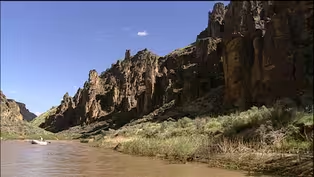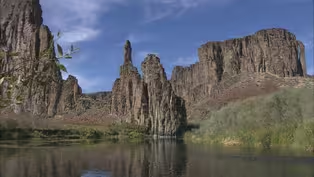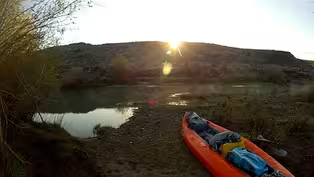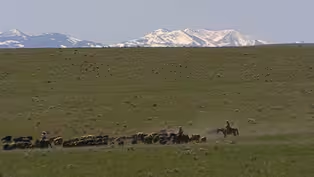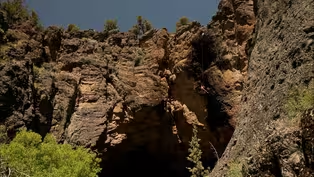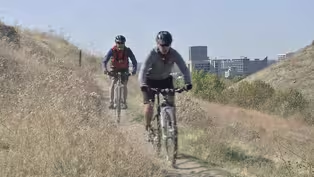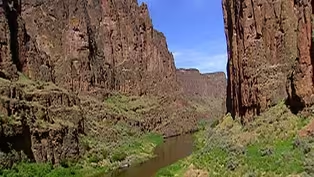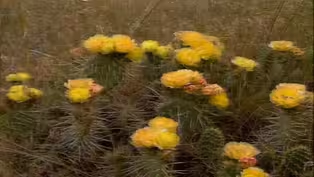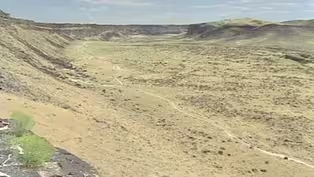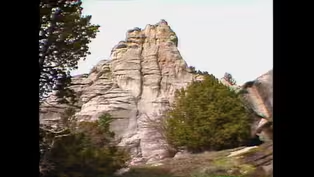
Spud Country
Season 39 Episode 3 | 26m 46sVideo has Closed Captions
Join Outdoor Idaho as we dig into what it truly means to live and work in “Spud Country.”
In Idaho, raising spuds is a traditional way of life. From planting to harvest, potato farming provides not only food, but culture too. Dubbed the “potato state,” more than half of Idaho’s counties grow potatoes. But beyond the numbers, what matters is the goodwill of Idaho’s agricultural community. Join Outdoor Idaho as we dig into what it truly means to live and work in “Spud Country.”
Problems playing video? | Closed Captioning Feedback
Problems playing video? | Closed Captioning Feedback
Outdoor Idaho is a local public television program presented by IdahoPTV
Major Funding by the Laura Moore Cunningham Foundation. Additional Funding by the Friends of Idaho Public Television and the Corporation for Public Broadcasting.

Spud Country
Season 39 Episode 3 | 26m 46sVideo has Closed Captions
In Idaho, raising spuds is a traditional way of life. From planting to harvest, potato farming provides not only food, but culture too. Dubbed the “potato state,” more than half of Idaho’s counties grow potatoes. But beyond the numbers, what matters is the goodwill of Idaho’s agricultural community. Join Outdoor Idaho as we dig into what it truly means to live and work in “Spud Country.”
Problems playing video? | Closed Captioning Feedback
How to Watch Outdoor Idaho
Outdoor Idaho is available to stream on pbs.org and the free PBS App, available on iPhone, Apple TV, Android TV, Android smartphones, Amazon Fire TV, Amazon Fire Tablet, Roku, Samsung Smart TV, and Vizio.
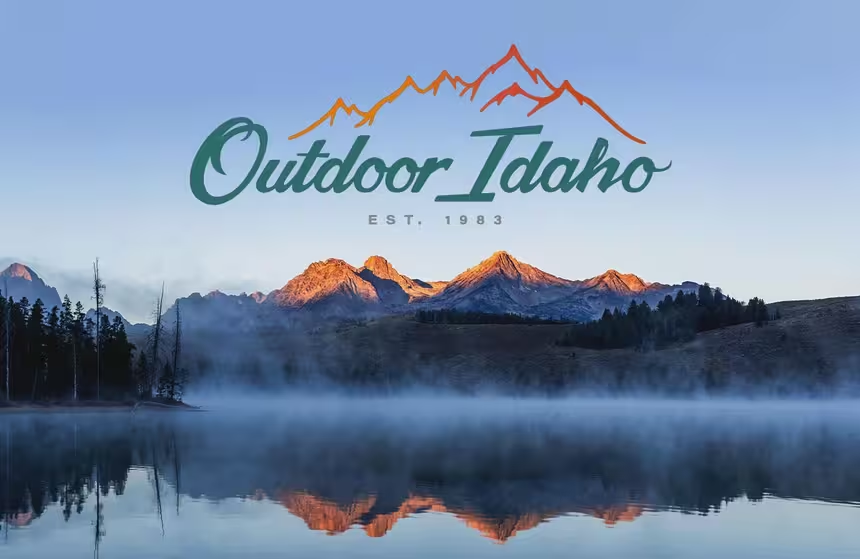
Outdoor Idaho on YouTube
Can't get enough Outdoor Idaho? Neither can we. Subscribe to the Outdoor Idaho YouTube channel for even more great content. You'll find full episodes, sneak peeks, behind-the-scenes footage, and exclusive content you won't find anywhere else. Subscribe today!Providing Support for PBS.org
Learn Moreabout PBS online sponsorshipMore from This Collection
Southern Idaho
Video has Closed Captions
The Owyhee Desert is a remote but fascinating landscape. We visit some of its wonders. (26m 48s)
Video has Closed Captions
A collection of diverse local groups found common ground to craft the Owyhee Initiative. (26m 47s)
Video has Closed Captions
Follows various groups adventures through the Owyhee Canyonlands. (26m 46s)
Video has Closed Captions
Outdoor Idaho travels to the lonely corridor along the Nevada-Idaho border. (26m 49s)
Video has Closed Captions
Owyhee Canyoneers follows a group of canyoneers into the Pole Creek Wilderness. (26m 49s)
Video has Closed Captions
A remote high desert where cowboys still ride the range and rafters navigate rivers. (26m 49s)
The City of Rocks has a weird beauty that fascinated travelers on the California Trail. (28m 53s)
Providing Support for PBS.org
Learn Moreabout PBS online sponsorshipBRUCE REICHERT, HOST: In a dusty landscape with skies that change quickly as if dependent on the moods of gods and mountains that loom in the backdrop, a leafy plant grows quietly, unaware of its profound impact on humanity.
JEFFRY BOHLSHIED, FOOD SCIENTIST: If you really look at what the potato is, it's roughly the third, most important food crop in the world.
You can get more calories, more protein and more vitamins and minerals per acre with potatoes than you can most any other food.
REICHERT: And the Idaho spud is arguably the most famous spud of all.
CELIA GOULD, DIRECTOR OF AGRICULTURE: Throughout the United States, nobody has done a better job of marketing a crop than the Idaho Potato, nobody.
We've got that one locked up.
JONATHAN HOGGE: You know, agriculture is the economic driver in Eastern Idaho, probably in Idaho period.
REICHERT: To live and work potatoes is to embrace the good, the bad, and everything in between.
(cheering).
GOULD: I think farming's pretty much in people's blood.
It's part of our culture.
It's who we are, you know, you become part of the land probably more than it should.
It becomes part of your identity.
MELANIE SCHWENDIMAN, SCHWENDIMAN FARMS: I love everything.
I love the smell of the dirt.
I love driving the truck.
I love being with the people.
I just, I just love everything about it.
MICHAEL STEINMANN, POTATO SEED FARMER: You have to enjoy it or life would be terrible.
REICHERT: From tuber, to tater, the Idaho spud has filled the bellies and captured the imagination of the entire country.
FRANK MUIR, FMR.
PRES.
OF IDAHO POTATO COMMISSION: Research proves it out, you say Idaho, the number one word that comes out of consumers' minds is potatoes.
TISH DAHMEN, EXEC.
DIR.
OF IDAHO POTATO MUSEUM: It's great to be the potato state.
It's wonderful to have that reputation to be associated with that such a humble, versatile and important vegetable.
REICHERT: Sure, it's just a potato, but in spud country, it's so much more than that.
DAVID SCHWENDIMAN, SCHWENDIMAN FARMS: We live in America.
We live in a great country and the freedoms that we have, we're our own boss, we live close to the land.
We have great families, beautiful surroundings, clean water, great state.
Uh, it doesn't get any better than this.
ANNOUNCER: Funding for Outdoor Idaho is made possible by the Laura Moore Cunningham Foundation committed to fulfilling the Moore and Bettis Family Legacy of building the great state of Idaho by the Friends of Idaho Public Television, by the Corporation for Public Broadcasting.
REICHERT: Baked, mashed, fried, boiled, skinned, hashed, chipped, crinkled, scalloped, The potato is truly a multi-purpose food.
And not only does it taste good, but there's just something about the Idaho potato that gets to people.
From songs, (MUZZY BRAUN: Well there never was a tater like the Idaho spud).
to celebrations.
The Idaho spud is just about as iconic as a root vegetable can be.
But as you might expect, the tuber comes from a humble beginning HANNALORE HEIN, IDAHO STATE HISTORIAN: Most historians and most scholars would agree that the first potato came to Idaho with two missionaries in 1836, Henry Hammond Spalding, and his wife, Eliza Spalding.
They were Oregon Trail pioneers coming west.
So the decision to settle the mission at Lapwei, provided space for agricultural endeavors and one of the first crops that they cultivated were potatoes.
REICHERT: We've come a long way since those early pioneers planted fields by hand and horse.
But one thing sure hasn't changed, when the wind blows, the dirt blows too.
SCHWENDIMAN: So planting potatoes right here in this field.
We've got about 500 acres left to plant on this farm.
And then over at Newdale, we've got several thousand to plant ahead of us.
So we've got our work cut out for us.
REICHERT: 26 of Idaho's 44 counties farm potatoes, producing 13 billion pounds annually.
That's nearly 300,000 acres of potato fields in our state that are responsible for one third of all the potatoes in the U.S.
So why here?
BOHLSCHEID: What we have in Idaho is, is very what we call friable soil.
So it's sandy loam and it breaks up very easily.
There's not a lot of organic material in the soil, but it's a very high mineral content and it's slightly alkaline, so it's not neutral.
They can grow much larger and you get more potato tubers per plant.
REICHERT: Aside from soil.
The other key ingredient to a successful yield is starting with a good seed and when you're growing potatoes that just means well, a good potato.
STEINMANN: The only difference really is that the seed potatoes have to go through a more rigorous certification process than commercial potatoes.
But as far as the potato itself, there's really no difference.
You can eat seed potatoes, just like commercial potatoes.
REICHERT: While some seed growers like Michael Steinmann plant straight into the fields, others, like Clen and Emma Atchley, start their seeds indoors.
EMMA ATCHLEY, SEED POTATO GROWER: I operate a greenhouse in which we raised the tissue cultured plantlets to produce what we call mini-tubers, which are completely disease-free potatoes.
And they become the basis for all of our field production.
CLEN ATCHLEY, SEED POTATO GROWER: You've got to get good yields to stay in business.
That's, that's all yield times dollars.
And that's what this whole industry is about.
If you can't get the yield or you can't get the dollars and that variety is going to go away, EMMA ATCHLEY: It's what I call a true creation of wealth.
So much of what we consider wealth now is immaterial.
And this is material wealth in the sense that you produce something that has a value.
And I find that gratifying.
It always amazes me that we can accomplish that with science and with just the practical use of the plant material.
REICHERT: Science.
That's one thing you don't think of when you pick up a sack of potatoes at the grocery store, but without it, our potatoes might not be as plentiful or appealing.
You can see that firsthand in one of the most unlikely of places.
In the small town of Aberdeen, at the Aberdeen Research and Extension Center.
REICHERT: It's a place where the University of Idaho and the U.S. Department of Agriculture collaborate with the goal of breeding the perfect potato.
WHITWORTH: It's just trying to take a lot of different traits that seem very hard to get all in one potato and trying again and again, to incorporate more of those traits, because you want something that grows well, yields high and you want something that, that has reduced fertilizer needs, reduced water needs, reduced pesticide needs.
And those are all difficult to get in one package.
NOELLE ANGLIN, RESEARCH GENETICIST: Breeding is not only a science, but it's also an art and some of the best breeders I know, they can look and say, that is the one and it's almost instinctual.
REICHERT: Before hitting the market, the new potato variety is written up in a peer-reviewed journal and then it's tested by companies and farmers.
ANGLIN: It's difficult to get the growers to change their mind because, you know, if they know that they can make a lot of money with Russet Burbank or another potato, why do they want to change it?
They're putting their livelihoods at stake by changing the varieties they grow.
WHITWORTH: From the production side of things, if you don't have the margin, you're not going to have a farm and you're not going to have the potatoes.
REICHERT: A world without potatoes, that's unimaginable.
Even more so when you think about the trickledown effect from Idaho's potato industry.
HOGGE: The amount time, amount of dollars that are being spent, you know, on this production.
And then the amount of those dollars coming back into the community, through the grocery stores, through clothing stores.
It is one of the most powerful, economic drivers that you can have in a system.
PHILIP WATSON, PROFESSOR OF AGRICULTURAL ECONOMICS, U OF I: There's about between five and 6,000 people who work on the farm directly in potato production.
So that'd be farmers and farm workers.
And then another five to 6,000 who work in processing and the chipping and, and all the processing potatoes.
And when you add up all those jobs, we're talking more like, you know, 24,000 jobs in the state of Idaho that can be directly tied to potato production.
GOULD: Well yeah, that's 4 billion dollars to this state, and there are so many jobs that circulate around it that I don't think we fully account for all of the trickle down that comes from the potato industry.
REICHERT: While money and machinery might be two must haves in the potato industry, without a doubt family is what makes it all worth while.
SCHWENDIMAN: I think anything you do is fun, but if your family that you love is with you, there's just nothing like that.
And I've loved working with our girls.
We've got five girls, they all drive truck about two boys and they're on the equipment and now the grandkids, they're just, I just love them.
STEINMANN: It's not an easy thing.
I mean, it really is not an easy thing, but it is a rewarding thing and it's a good way to raise a family.
STEINMANN: My youngest son, he runs the digger.
I've got nieces and nephews that come and help.
And so it's really kind of a family deal.
And you know, it's pretty good that way.
SCHWEDIMAN: You just have to do the best you can do every day.
And sometimes, you win, Sometimes you get kicked around a little bit, but we've got a good crew and everybody knows their job and I think we're going to win more than we're going to lose.
REICHERT: And if you don't work with actual potatoes, there's still a way to get up close and personal with spuds.
[Singing: They're red, they're white, they're brown, they're typically underground] The Idaho Potato Museum in Blackfoot.
It's is all things potatoes, all the time.
REICHERT: From potato peelers, to potato mashers to potato tractors, the museum digs deep to the root of Idaho's potato industry.
DAHMEN: It's fun, it's quirky, they're learning something.
Also historic, they're reconnecting to their food source, but I think number one, they just really have a good time.
REICHERT: Just up the road from the Idaho potato museum is the town of Shelley, where one day a year on Shelley Spud Day, the town comes alive in celebration of the spud.
(CHEERLEADERS: Let's go big red) JEFF KELLEY, SHELLEY KIWANIS CLUB: It's just kind of an area pride thing.
It's not just Shelley.
Nowadays it's all the way from American Falls to Ashton.
REICHERT: From a parade and the crowning of "Miss Russet."
To a mashed potato tug of war.
It's easy to see, potatoes truly are quintessentially Idaho.
REICHERT: By now, you've probably realized, the Idaho spud is not just a regular ol' potato.
It's special.
Our ancestors would've been hard pressed to believe something like a potato could be, dare we say it, fun?
(WOMAN: Hi) FRANK MUIR, FRM.
PRES.
OF IDAHO POTATO COMMISSION: For the last 10 years, people have embraced the potato.
They're seeing the fun we're having with it.
REICHERT: The spectacle that is the Big Idaho Potato has been turning heads since 2012, visiting fairs, parades and festivals in 48 states.
Fans can even follow it from afar, at potatotracker.com.
KAYLEE WELLS, BRAND AMBASSADOR: The potato is 8,000 pounds.
It's made out of fiberglass.
It has a steel frame.
It's 28-foot long, 10-foot-wide, which actually makes us an oversized load.
But if the potato was real, it would make a million French fries and over 20,000 servings of mashed potatoes.
(WELLS: Here's a little souvenir now that you saw the potato truck).
WELLS: We bring joy everywhere we go.
We bring excitement.
We bring wonder.
It's just such a unique job.
Like, I'm never going to have a job like this ever again in my life.
REICHERT: The Idaho Potato Commission hasn't always been the cool kid.
When Frank Muir interviewed for the job in 2003, the Legislature was considering taking the potato off the Idaho license plate and low-carb diets were pushing potatoes off American dinner plates.
The Idaho potato was in a slump.
MUIR: I felt the brand had become stagnant, stale.
We're going to change things.
We're going to make the potato relevant and cool in today's popular culture.
REICHERT: The agency known today as the Potato Commission was born in 1937, financed by a fee on every spud grown or sold in the state.
Today it gets $14 million a year for promotion and research and for work with retailers and food service companies.
And yet, when the ad agency first proposed a giant potato for the commission's 75 anniversary, the genius wasn't obvious.
MUIR: When I first presented the idea to the commission, all nine voted against it.
Now, I have said many times in my career, every new idea is crazy until it works.
COOMBS: Ready to go to work.
REICHERT: One of the votes against that crazy idea was Mark Coombs, a farmer on the Potato Commission.
After the commission did decide to take a chance on the Big Idaho Potato, the agency came up with the idea of commercials featuring a farmer chasing that truck around the country.
And Mark Coombs got a phone call.
Coombs, POTATO FARMER, ACTOR: I says what?
You want me to be the talent for your commercial?
COOMBS: Hello, I'm an Idaho Potato Farmer.
So, here I am.
But Coombs learned his lines and hit his marks, and he and the Spud Hound have now starred in 10 ads.
In the latest, he sculpts with mashed potatoes and dreams about waffle fries raining down.
REICHERT: Still, the spud farmer and the Spud Hound may be outshined by a dancing spud.
WELLS: People love taking photos with him.
And Spuddy Buddy actually got on stage at the Braun Brothers Reunion.
They love getting selfies with him.
They love hugging him, giving him high fives.
Kids love him.
He's honestly the star of the show.
REICHERT: Dancing potatoes, traveling potatoes, raining potatoes.
These are all part of Frank Muir's legacy.
He retired in fall 2021 after 18 years as Idaho's premier potato promoter.
REICHERT: One of the crazy ideas, was about New Year's Eve.
CLINE: And I had a thought that maybe we could drop an Idaho potato instead of a ball like New York drops.
We built our first big, huge Idaho potato for New Year's Eve, and we dropped it in 2013.
And the rest is history.
MUIR: When you see 30,000 people coming out to celebrate your brand in that kind of weather, it tells you something.
It tells you you're doing something right.
REICHERT: In Fairfield, at Galena Summit, along the Salmon River, smiling fans greet the traveling potato at every stop.
Even an unplanned stop on Highway 20.
Not the first time the truck has been pulled over for police selfies.
BRADFORD: What other job can you have where you pull up and people give you an all-five finger wave and a big smile?
That's their first reaction every time.
I was born to do this job.
REICHERT: Now, being the potato state, it only makes sense that some of the largest potato processing companies in the world are located right here in spud country.
And to see it is to be struck dumb with the realization that your French fries, tots and hash browns likely came out of a place like this.
The Simplot foods processing plant in Caldwell.
A whirlwind of high tech machinery that transforms dirty, raw potatoes into easily recognizable and delightfully delicious appetizers.
The Caldwell plant goes through 6 million pounds of raw potatoes a day - producing about a third of McDonald's French Fries.
The Simplot story and the Idaho spud's rise to fame are undeniably entwined.
Largely thanks to this man.
J.R. SIMPLOT, SIMPLOT FOODS: Who'd ever thought I'd get to where I am today, it's a rather miracle.
I don't think there's a better place to live in the world, than right here in Idaho.
I think this is the Garden of Eden.
REICHERT: J.R. Simplot or Jack, a man known for his entrepreneurial spirt - and his colorful personality.
SIMPLOT: I hired them for brawns and stamina and not too many brains, because nobody had them.
BRUCE NEWCOMB, FORMER HOUSE SPEAKER: He was a unique individual.
Here's a kid with an eighth grade education and look what he accomplished.
And yeah, he had a mistress, it was the Simplot Company, you know.
HEIN: Where he recognizes the risk involved, but the mindset is so strong and so great that he knows that through perseverance and determination and his own hard work, he will be over to be able to overcome those challenges.
NEWCOMB: But he was kind of the man that got potatoes going in the sense that as soon as the Second World War started, he was able to come up with the dehydrated potatoes for the armed services, and it just kind of grew from there.
REICHERT: This truly puts Idaho on the map for potato production.
And from there, potato contracts became the name of the game.
RAYBOULD: It's one of the ways that over the years, growers have found to help them balance their risk between potentially what they could get selling on the open market if the demand was high and the supplies aren't quite there.
This isn't something that, can just work by itself without the support of the community and the support from the state, long-term this is going to require sort of that continued understanding and, and support of what it takes to do this job and if it gets taken for granted, uh, it may not always be here.
REICHERT: But for now, potato farming is here to stay and in the weeks leading up to harvest, the plants are at their prettiest.
Flower blossoms, green vines.
And views from above as nutrients are applied via airplane.
REICHERT: Potato plants are not the easiest crop to raise, they require lots of water and lots of attention, and even then, a successful yield isn't guaranteed.
RICARDO CHALES RAMIRES, SOUTHWIND FARMS MANAGER: It's always nervous.
Yeah.
It's nothing, you know, it's a lot of money and everything, so yeah.
Every day it's when we start from planting everything, it's always nervous.
Yeah.
Till we get every one of them out and we okay after that.
REICHERT: But like everything in the potato world, timing is everything.
And that is especially true when it comes to harvest.
MELANIE SCHWENDIMAN: I think it's kind of fun to see how long you can work like a 16 hour day.
That's kind of fun to say that you've worked out.
I think that's really a fun thing.
So night after night, you know, by Sunday when you finally get to rest, that is a nice day.
But yeah, I don't mind that.
REICHERT: For about three weeks, farmers, their families and their hired help spend from sun-up to way past sun-down trying to get potatoes out of the ground as quickly as possible.
REICHERT: A harvester runs down the rows, picking up potatoes, while a truck follows alongside, catching them.
MELANIE SCHWENDIMAN: I just want to be the very best truck driver there is.
Not that I want to be better than anybody else.
I just want to be just the very best.
REICHERT: It takes many hands to complete harvest on time and that, well that's where the high schools come in handy.
It's been a long tradition for schools in eastern Idaho to let students out on a 2-3 week "harvest break."
During that time, schools close and students have an opportunity to go work on potato farms.
RHETT LOWDER, STUDENT WORKER: My first couple of years I was just picking dirt, clods and weeds out of the belts.
But now I'm running the yard instead of just sitting there all day.
REICHERT: Along with making money, the high schoolers learn something else too.
KIM LEON, STUDENT WORKER: Just appreciate your potatoes, it's hard, it's pretty fun, I recommend doing it.
I'm going to appreciate mine from now on.
REICHERT: And when it's all said and done, the potatoes are harvested and in the cellars, and the kids are back in school, the sun is setting earlier and the mornings are getting colder, there's time to remember back on that potato field, what it's like to be totally present .
MELANIE SCHWENDIMAN: I think sometimes you have to experience it.
You have to be out here and smell this dirt and see people that are giving their very best effort.
There's just something so fulfilling about providing food and an experience a work experience for people, for yourself.
It, it just grounds you.
This is where it's at.
This, this is where good people are, this is where, you know, this is where life is right here.
So I just love potato harvest.
I love, I just love this part of Idaho.
ANNOUNCER: Funding for Outdoor Idaho is made possible by the Laura Moore Cunningham Foundation, committed to fulfilling the Moore and Bettis family legacy of building the great state of Idaho, by the Friends of Idaho Public Television, by the Cooperation for Public Broadcasting.
To find more information about these shows visit us at.

- Science and Nature

Explore scientific discoveries on television's most acclaimed science documentary series.

- Science and Nature

Capturing the splendor of the natural world, from the African plains to the Antarctic ice.












Support for PBS provided by:
Outdoor Idaho is a local public television program presented by IdahoPTV
Major Funding by the Laura Moore Cunningham Foundation. Additional Funding by the Friends of Idaho Public Television and the Corporation for Public Broadcasting.
